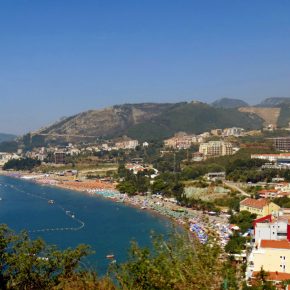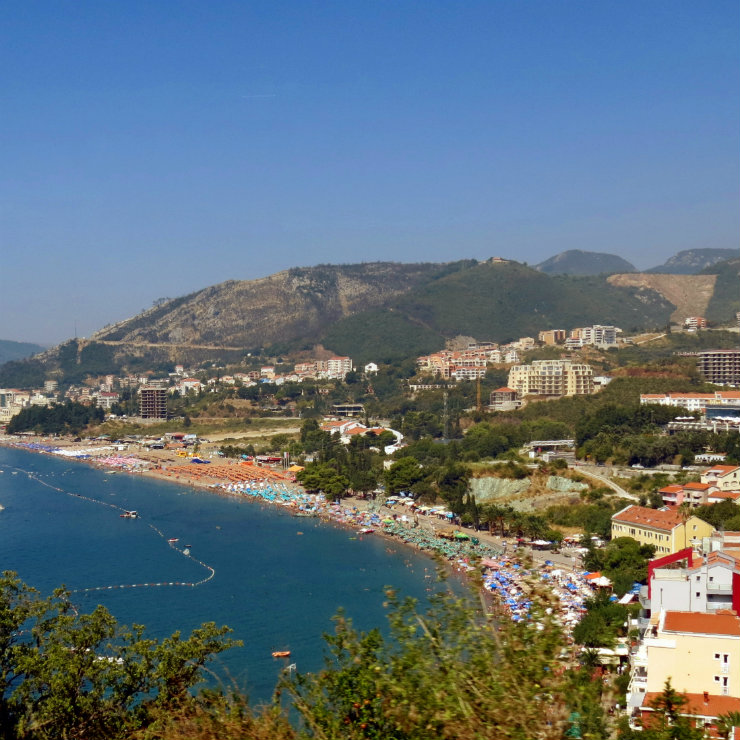Tydzień w gospodarce
Category: Trendy gospodarcze
Analyst, journalist specializing in the Western Balkans and Middle East domestic and foreign affairs

Budva Riviera, Montenegro (Natalia Semenova, CC BY)
Real estate prices are one of the factors that greatly affect financial stability. In most cases, the price rise on the capital market can be a significant threat to financial stability and the banking system. For long time there hasn’t been official price movement statistics on this market, but the Montenegrin government tries to closely monitor these transactions, as it is important for the long-term and sustainable growth of the Montenegrin economy.
The real estate market has experienced a strong growth over the last few years, much stronger than in the neighbouring Adriatic countries. The most important factors of growth were the initial underestimation of the real estate values (especially in the littoral area), gaining macroeconomic stability, the development of the banking system, the rapid development of the capital market, the attractiveness of the Montenegrin coast and significant interest of foreign buyers. Among these, Russians were the strongest bidders and buyers of the Montenegrin real estate.
In 2012, more than 40 per cent of sold real estate went to Russians. Montenegro was termed to be the Russian VIP leisure place, after the Montenegrin political elite decided to sell hotel complexes on the coast, together with the local industrial giants, such as aluminium factory in Podgorica, steel factory in Nikšić, bauxite mine in Pljevlja, to the Russian businessmen. For years, Russians have been second only to Serbians as the foreign owners of the real estate in Montenegro, combining 150 thousand square metres of space and more than 300 ha of land. In a small country like Montenegro, these are large numbers. The Russian buyers even built “Russian villages” above the seashore and there are some private Russian schools operating in Montenegro.
Last year, however, Montenegro experienced a big drop in the real estate prices and continues to be affected by the Russian pull-out, which was evident especially after Montenegro joined NATO Alliance. The trend of falling real estate prices may continue. The average cost of a square metre in a new dwelling last year was EUR1,000, which is 7,2 per cent less than in 2015. The average price of a square metre in a new building in the capital Podgorica was EUR1.090, in Budva Rivera EUR955 and in the industrial centre of Nikšić EUR599. Market recovery should not be expected soon. Impulses that could point to that direction, such as the dynamism of the economy or adjustments to real estate process have a delayed effect. The Montenegrin banking sector is also marked by high interest rates, so investors are no longer prepared to maintain high prices as they did earlier, despite the downturn in demand. This suggests that their current volume of sales does not provide the required level of profitability, which will further reduce their prices.
In the meantime, Montenegro lost Russian interest and now they are expecting some other buyers. Lately, large investments are seen from the Turkish and Arabic side. Since beginning of 2017, Turkish customers started to buy real estate all over the country, mostly in Budva Riviera. Usually, they buy flats and apartments worth between EUR50,000-EUR70,000. The Russian middle class, which was most interested in real estate acquisitions, is affected by the same factors as all the others, and most of all by the currency risk. The USD is weak, as well as the RUB.
The main feature of 2017, however, was the return of the customers from the European Union and local agencies suggest it is because of the Montenegrin membership in NATO. This step is still politically debated, but from the economic view it is very important for the development and the real estate market. NATO membership means the state is safe to invest in. With the growth of Western European customers’ interest, the main destination also changed. Instead of Budva, which was once the most desirable destination for real estate business, Boka Kotorska took over the primacy. This beautiful bay, with Kotor as its main tourism destination, is long considered to be a jewel of the Montenegrin coastline. Clients from the European Union are mostly opting for the Boka Kotorska and are more inclined to cultural and historical tourism.
Boka Kotorska is now the largest destination for the foreign investment in real estate. In Herceg Novi, the Porto Novi marina is being built, together with some 300 luxury apartments. In Luštica Bay there are investments in hotels and over 1000 residential apartments and villas. A penthouse in Porto Montenegro costs from EUR250,000-EUR5.5m. Apart from the Mediterranean-Venetian architecture, buyers also get a luxurious service. In this tiny strap of the Montenegrin coast, a main idea is to built a new Monaco. The local owners tend to wait, as there are always buyers of the most expensive real estate. In last ten years a total of 260 houses and apartments, worth over EUR200m, have been sold in Porto Montenegro. Buyers are from all over the world, and most numerous are those from Russia, Serbia, United Kingdom, Montenegro, Italy, the United Arab Emirates, Ukraine, the United States and Bulgaria.
Vedran Obućina is an analyst and a journalist specializing in the Croatian and Middle East domestic and foreign affairs. He is the Secretary of the Society for Mediterranean Studies at the University of Rijeka and a Foreign Affairs Analyst at The Atlantic Post.


